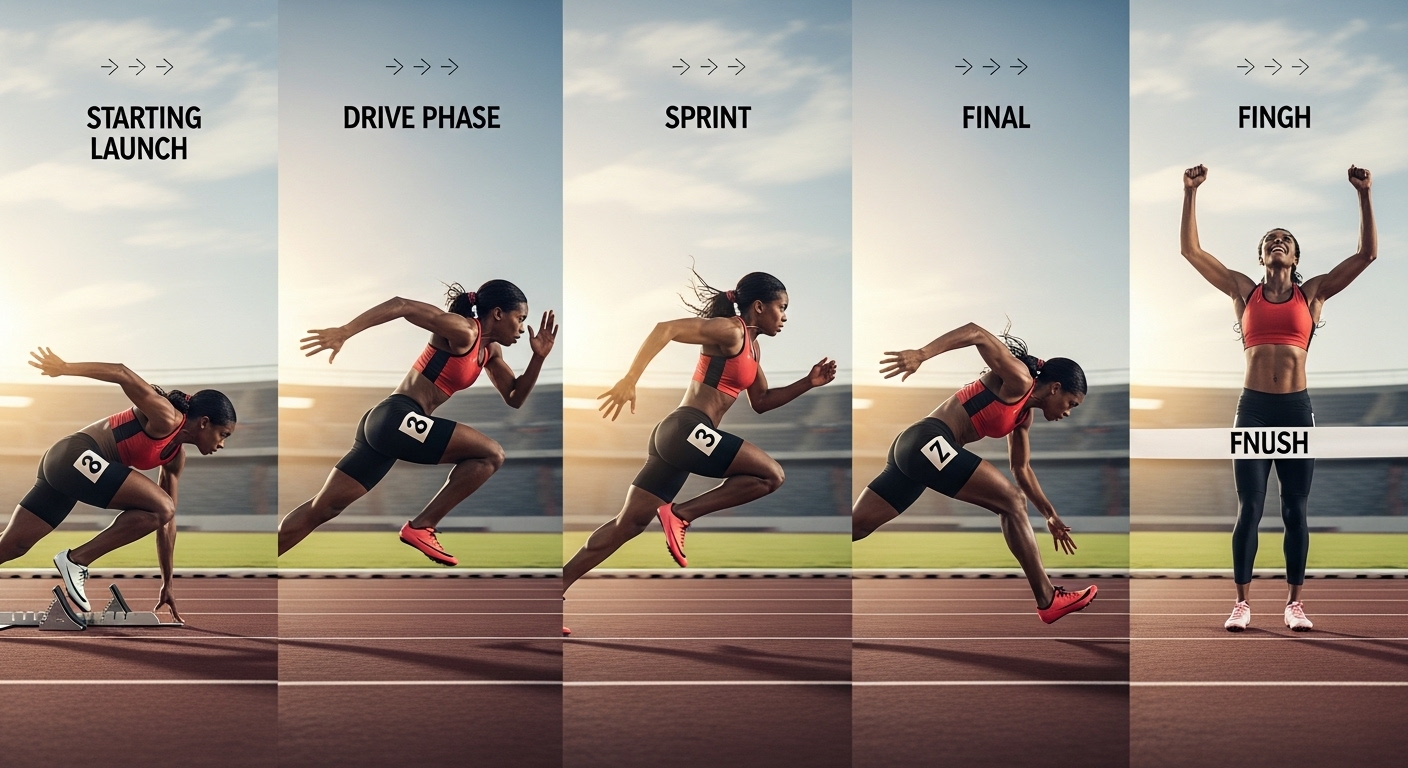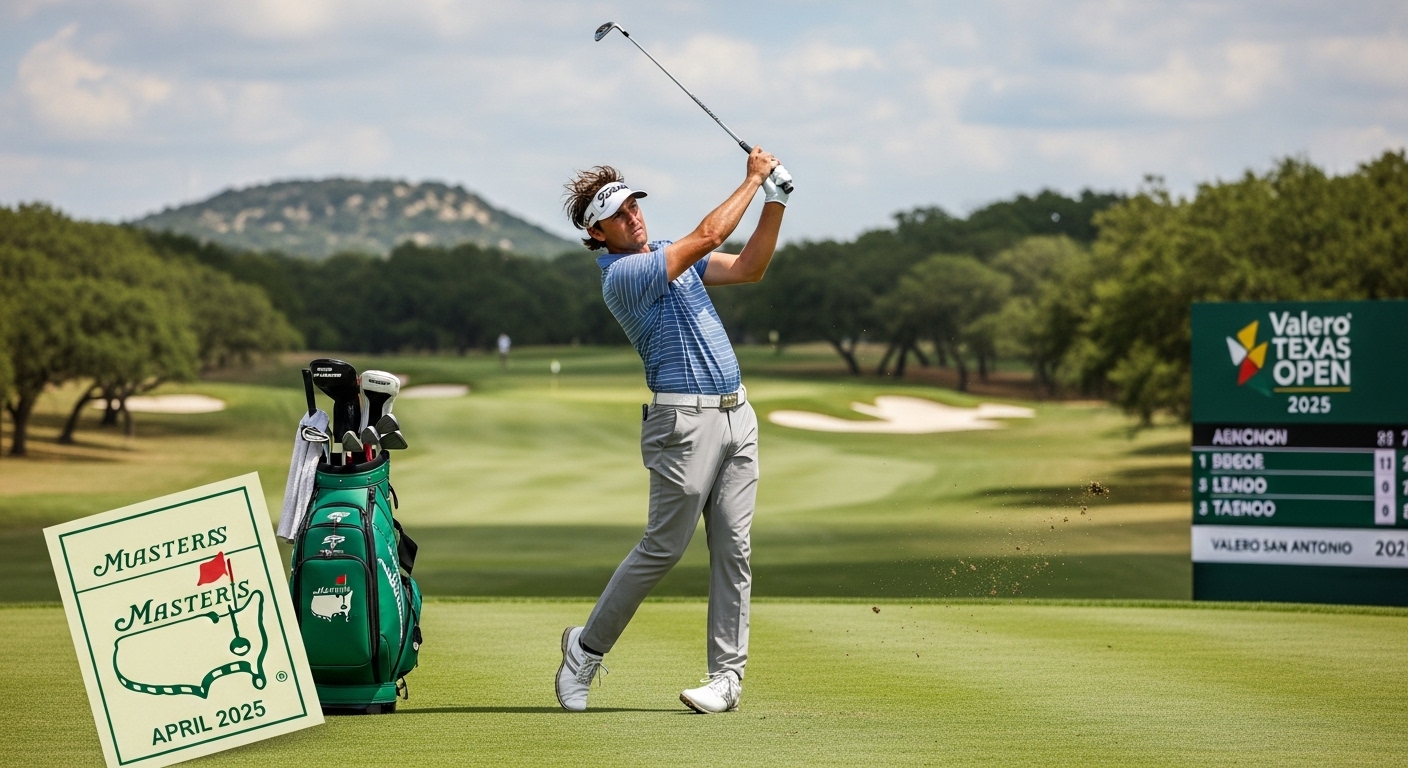As someone who has spent 12+ years timing starts, arguing with starters, and rewinding photo finishes, here’s the quick version: the women’s 100m rewards the best start, the best drive phase, and the cleanest top speed under pressure. If your reaction time is sharp and you stay relaxed when it’s chaos, you win. That’s it. The rest is noise. And yes, I still get chills at the blocks. Sprint nerd forever.
What actually decides who crosses first?
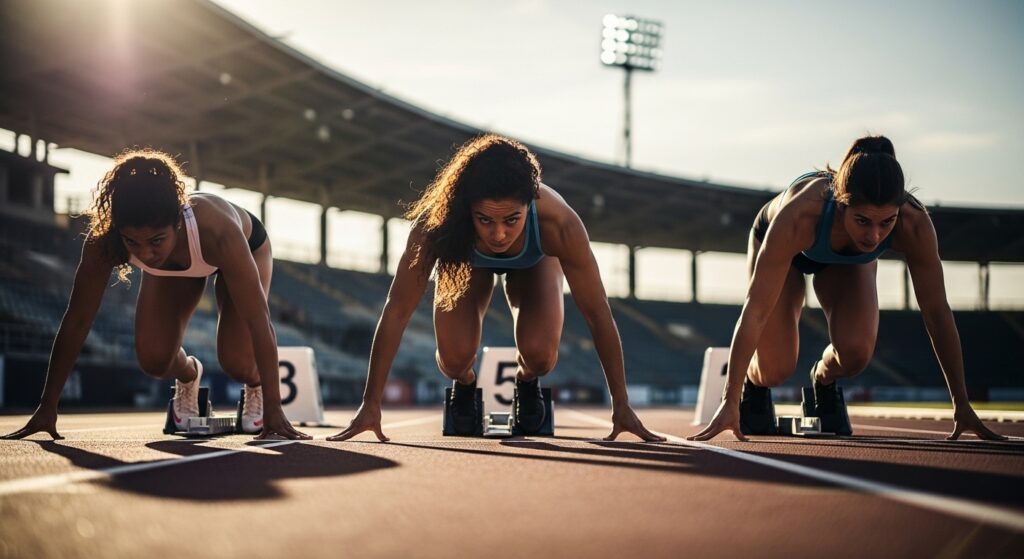
I’ve always found that sprint races are won in three places: the first 30 meters, the mid-race transition, and the last 20 meters when form falls apart. Sounds basic. It isn’t. The start is a skill. The transition is a test. The finish is a choice. Also, the clock doesn’t care about your feelings.
The five parts I teach (and obsess over)
- Reaction: Hit the gun, not before it. A legal reaction is 0.100s or slower. Faster than that? It’s a false start, not magic.
- Drive phase (0–30m): Push hard, low angles, big power. Don’t pop up early. I can see panic from 60 meters away.
- Transition (30–50m): Rise tall, find rhythm, keep pressure on the ground. This is where races go quiet in a good way.
- Max velocity (50–70m): Float but fast. Stride frequency meets stride length. Relax the face. Jaw tight = times slow.
- Speed endurance (70–100m): Hold shape. Knees up, hips high, arms tight. No hero moves. No fishing for the line.
| Phase | Typical Range | Coaching Cue | Common Mistake |
|---|---|---|---|
| Reaction | 0–10m | Hear, don’t guess | Flinch at “set” |
| Drive | 0–30m | Push, push, push | Standing up too soon |
| Transition | 30–50m | Grow tall | Overstriding |
| Max Velocity | 50–70m | Quick feet, loose face | Tight shoulders |
| Speed Endurance | 70–100m | Hold posture | Leaning or reaching |
If you like keeping up with gear shifts in track (spikes, block tech, track surfaces), I dump my takes under sports trends when I’m not at the track with a stopwatch and too much coffee.
Records, wind, and why your PR needs an asterisk
Let me say this gently: wind matters. A +2.0 m/s tailwind is the legal limit. Anything stronger is fun for Instagram and useless for record books. If you want the boring-but-true history lesson, the official record progression is here (women’s 100m world record progression). It shows the trend: faster tracks, smarter training, better spikes. And still, the basics rule.
When I compare athletes, I check wind, altitude, and reaction time. Then I peek at the all-time list to sanity-check my gut. The numbers don’t lie, even when our eyes do. If you’re nerdy like me, bookmark the World Athletics all-time toplists. It’s my second brain.
Starts, false starts, and the 0.100 rule
The block sensors measure force against time. If the system detects a reaction faster than 0.100 seconds after the gun, you’re out. People argue reflex vs anticipation all day. I’ve stood in too many protest rooms to know: arguing doesn’t move the clock. Train your ear. Control your breath. Be a statue in “set.” Then explode.
Training that actually moves the needle
In my experience, you get fast by training two things well: acceleration and max velocity. Everything else supports those two. I keep sessions short and specific. If an athlete still looks fresh after real acceleration work, we probably didn’t go hard enough.
- Acceleration day: 6–8 x 20–30m from blocks, full recovery. Add sled pulls (10–15% bodyweight). Quality over ego.
- Max velocity day: Fly 20s and fly 30s with long builds. Keep posture tall. Film everything.
- Speed endurance: 2–3 x 80–120m at 92–95% with full rest. Teach the body to hold shape when it wants to melt.
- Strength: Trap bar deadlifts, RDLs, hip thrusts, Nordic curls. Strong hamstrings save seasons.
When I profile athletes, I love telling their origin stories—because sprinters are characters. If you’re into those profiles, I stash them under athlete spotlights. Lots of “I ran in borrowed spikes” energy.
Spikes, tracks, and tiny edges
Spikes matter, but not as much as you think. A well-fitted, stiff plate helps your foot act like a spring. Tracks vary too—some are bouncy, some feel dead. If you’ve ever PB’d on a “slow” track, it was you. Not the asphalt.
Wind, weather, and lane draw
Headwind? Drop your angles and keep the arms compact. Tailwind? Don’t get greedy. A little extra wind makes athletes rush transitions, which ruins top speed. Lane draw matters less than people think, unless the stadium turns into a wind tunnel. Then, yeah. Lane 3 suddenly feels like a basement fan.
Where the big moments happen
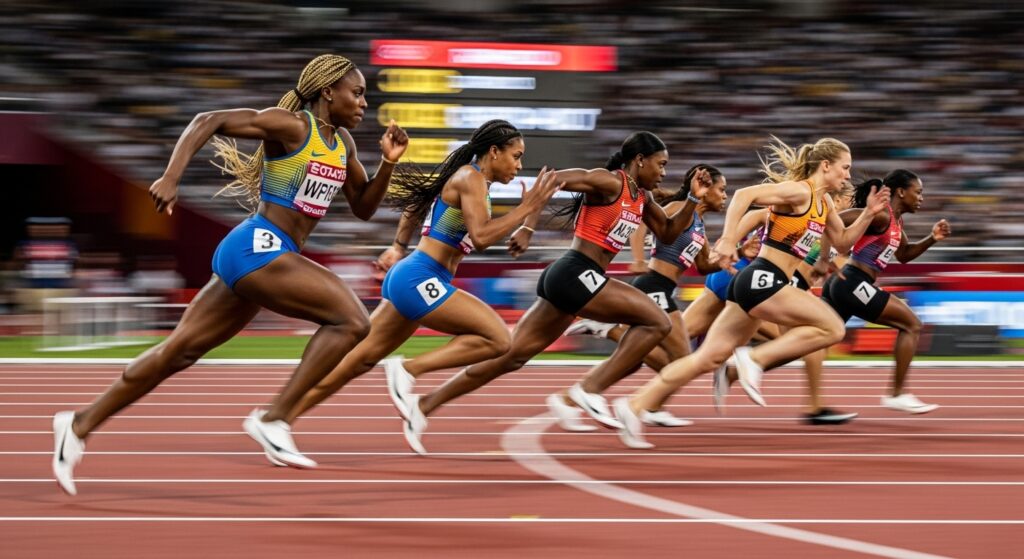
I track three circuits hard: national trials, Worlds, and Diamond League. The pressure at trials is unreal—make the team or go home. Worlds and the Olympics bring the heat every time. For broader context and cross-sport storylines I follow multi-sport news, because the narrative around an athlete can set the mood on the start line.
My quick scouting notes before a final
- Check recent 60m times: Tells me if the start and early acceleration are sharp.
- Look at 200m form: If their bend mechanics are clean, they usually hold posture well late in the 100.
- Watch warm-ups: Bouncy strides? Good. Shoulders creeping up? Uh oh.
- Reaction trends: Some athletes consistently hit 0.12–0.14. Others sleep to 0.18. That gap is huge.
| PB (s) | Typical Reaction (s) | 10–30m Split (s) | 70–100m Split (s) |
|---|---|---|---|
| 10.7–10.8 | 0.12–0.14 | 1.80–1.86 | 2.70–2.78 |
| 10.9–11.1 | 0.14–0.16 | 1.86–1.92 | 2.78–2.85 |
| 11.2–11.4 | 0.15–0.17 | 1.92–1.98 | 2.85–2.95 |
If you play fantasy track (we both know you do) and want to exploit those reaction-time nuggets or tailwind trap meets, I leave notes under fantasy tips. Not investment advice. Just fun math.
Common mistakes I see (and keep yelling about)
- Overstriding early: Long steps feel fast. They’re not. Short, violent pushes are king.
- Arm chaos: Arms set the rhythm. Keep them tight and punch back, not across.
- Chasing someone else’s race: Run your plan. If you react to lane 4, you already lost two tenths.
- Training like it’s cardio: Rest is part of speed. If you can talk between reps, you’re not sprinting.
A quick story from the rail
At national trials a few years back, I watched a favorite pop up at 15 meters, chase, tie up, then dive. Looked dramatic. Looked brave. The clock shrugged. Meanwhile, the quiet kid who stayed low through 30m and didn’t force it? PR, team made, tears with coach. The event is ruthless, but it’s fair.
For bite-sized replays and clean angles, I usually point friends to match highlights. Easier than scrolling through a thousand clips where the camera remembers to focus at 60m. Mostly.
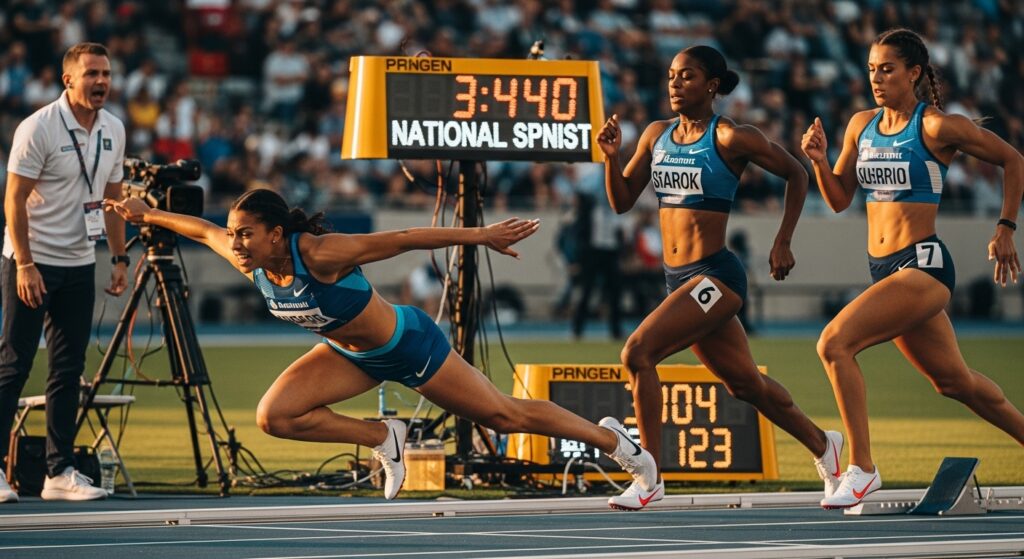
Need-to-know, fast
- Legal wind: +2.0 m/s tailwind max for records.
- False start rule: Faster than 0.100s off the gun = DQ.
- Training split: Two speed days, one strength day, one recovery/tempo day is a good baseline.
- Injury watch: Hamstrings and calves first. Glutes keep you honest.
- Meet rhythm: Heats, semis, finals. Energy management matters.
Oh—and since someone will ask—yes, I still think the start matters a hair more than the finish at the elite level. Margins are razor thin. A tenth at the gun becomes a meter at the tape. I’ve timed too many races to think otherwise. When I talk about the women’s 100m at dinner, my friends pretend to check their phones. They still listen though.
FAQs
What’s a good reaction time for a top sprinter?
Most elite reactions land between 0.12 and 0.16 seconds. Anything near 0.10 is lightning—and risky.
How much does wind really change the time?
A strong tailwind can be worth 0.05–0.10 seconds. Legal limit is +2.0 m/s. More than that doesn’t count for records.
What’s the best beginner workout for 100 meters?
Try 6 x 20m accelerations, full rest, then 3 x fly 20s with a 30m build. Keep it crisp. Stop before you get sloppy.
Do spikes make a big difference?
They help with stiffness and grip, but form and strength matter more. Bad mechanics in fancy spikes are still bad.
How do I stop tightening up at 80 meters?
Practice short max-velocity runs and relaxed sprint drills. Think “quick arms, tall hips, soft face.” It works.
Anyway, that’s me unloading years of stopwatch gossip and block-side opinions. If you made it this far, you’re either racing soon or you just like the chaos. Either way, same club. Oh—and if someone tells you the women’s 100m is “just who’s fastest,” smile and let them think that. We’ll be over here counting steps and arguing about the drive phase like it’s life or death.

I’m Oliver Scott, and I live to bring every sports moment to life. Get breaking multi-sport news, in-depth match highlights, fantasy tips, athlete spotlights, and the latest trends right here.

